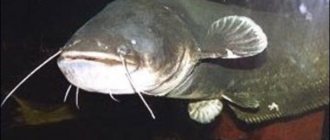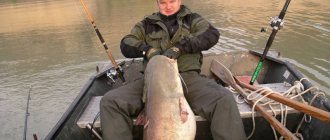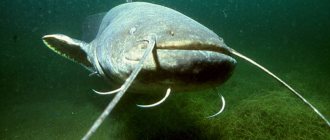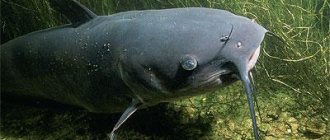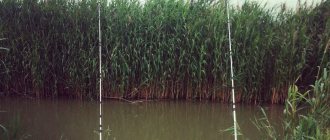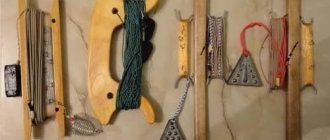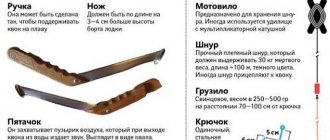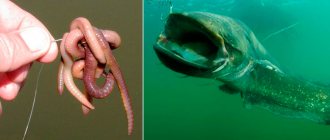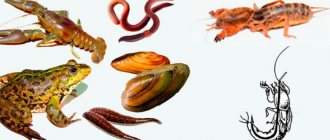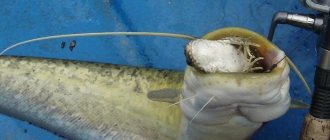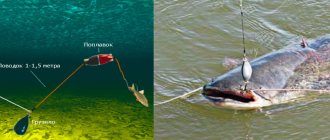Selection and production of kwok
Nowadays stores offer a huge selection of different quoks. Most often they are made of metal and wood. The material does not affect the sound produced at all; the size and shape of the quok do.
There are three main elements in the design of a quok:
- patch
- knife
- lever.
The handle is most often made from various types of wood. The main thing is that it is light and comfortable in the hand. It is best for the knife to be made of metal, as thin as possible, so that it can easily cut water, and at the same time there will be less splashes. The piglet is made from various materials: metal, wood, and epoxy resin. The main requirement for it is that it be perfectly smooth.
Well, the most important thing in the design is that the angle between the handle and the knife should be 60 degrees.
Experienced somyatniks make kwok with their own hands and immediately for themselves.
The handle is made of apple or maple. Set the shape and polish well. It makes a cut under the knife. The knife is inserted at the desired angle and sits on the glue. The knife is made from a duralumin plate 28cm long, 5mm thick and 2.5cm wide. can also be made from wood. A snout is attached to the end of the knife.
To make a heel, make a mold from plasticine and fill it with epoxy resin.
After manufacturing the entire structure, it is carefully sanded and varnished.
For fishing to be successful, you need to learn how to make the correct sound with a quok. To do this, at a certain moment you need to pull it up very sharply, and the sound produced depends on this. In order to achieve the correct movement of the hand, it may take more than one training to make the correct knock. This is done in this way. The kwok is taken in the hand so that its handle and forearm are located at an angle of 50 degrees. Next, we straighten our arm and the quok enters the water. With a sharp movement of the hand, we make the heel emerge from the water. When working with one brush, the sound is louder and more resonant.
You need to get used to each new quok and adjust again, adjust your striking technique.
Choosing a quok
The main criteria for choosing a device is the result of the sound of the instrument. The sound intensity depends on the size of the working area of the hoof. Equipping a quok with a striking surface with an increased area makes the sound lower and dull. Small working surfaces of the claw, on the contrary, make the sound sharp and sonorous, but short in time characteristics. The angler selects a device based on sound based on the preferences of the fish in a particular body of water.
As recommendations, beginners can be given directions in using sonorous instruments over small underwater pits and ditches in coastal waters with strong currents. The dull and low tone of the device is more effective over large areas of the reservoir in waters with calmer currents, where it spreads over long distances. As a rule, the device in its classic design looks like a handle and a cutwater, placed relative to each other at an angle of 60 degrees. But the classic is by no means a dogma of this bait; the angler has the right to choose a version of the instrument that is convenient for the hand and execution of the blow, the main thing is that its sound lifts the mustachioed predator from the bottom or lures it to the bait from cover.
Choosing places to fish
In order for fishing to please us with the result, we need to choose a good place for fishing. Catfish prefer to be in the deepest rivers and reservoirs.
He also loves absolute silence, then we need to find a place with a quiet pool or a large hole.
In large rivers, catfish can sometimes go out into estuaries. In small rivers, where shallows alternate with depth, the catfish has one developed path along which it constantly swims in search of food.
After spawning, when the catfish regains its strength, it is constantly in search of food; you can find it anywhere, or rather, it moves behind schools of white fish or is in places where there are a lot of crayfish.
Finding a fishing spot or a catfish parking area
The main places for catching catfish using kwok are pits and the adjacent water areas. It is better to search for such areas on rivers and reservoirs using an echo sounder and navigator. Promising areas are sharp turns of rivers with steep steep banks, whirlpools, exits into oxbow lakes and spills with rich aquatic vegetation.
Major Craft spinning rods - how to choose the right model for the desired type of fishing and bait.
How to make a donk and catch catfish with it - selection of baits and the right approach.
Selection of spinning rods, what details you need to pay attention to when choosing a spinning rod.
The best time of year to catch catfish with a kwok
Spring
After winter, the catfish begins to move a little when the water temperature reaches 10 degrees Celsius. Depending on weather changes, the bite can begin either at the beginning of April or at the end of the month. As the water warms up, it likes to be in shallow water, where it basks in the sun.
In spring, the bite is very unstable and is mainly effective only on warm days. The best time in spring for fishing with quok is in May. Catfish begin to actively feed before spawning; catches can be very large.
In summer
Summer is the best time for quok fishing. In the first days of the month, mostly small catfish bite, and from the middle of the month after spawning, active feeding on larger specimens begins.
In extreme heat during the day, the catfish is completely inactive and prefers to sit in deep holes, and goes hunting early in the morning or in the evening after sunset. He comes closer to the shore to profit from frogs.
By mid-summer, the catfish sticks more closely to the territory of its hole and finds food either at the edges or in the upper layers of the water.
Autumn
In the fall, catfish are caught before the onset of frost, and then they completely settle in their wintering place. In September, as it gets colder, the catfish begins to feed more actively, so to speak, making final preparations for wintering; this is the best time in the fall for fishing with quok.
It can be caught throughout the day if the weather is favorable. In rainy and windy weather, the catfish prefers to wait in the depths.
By mid-autumn, catfish practically stop being caught and rest in their shelter.
Fishing technique
It’s worth going together to catch catfish using kwok. If a large catfish bites, it is almost impossible to pull it out alone, so we bait the tackle and lower it to a depth of 5-7 meters. Under no circumstances should we wrap fishing line around our hand. If a large catfish bites, it can drag you away. Next, we begin to squawk, make three sharp blows and pause for 20 seconds. We immerse the quok no more than 10 cm in water. If there is no bite at a promising place, be sure to return to this place a little later and try again.
As soon as the catfish hears the sound of a quok, it rises up and meets the bait on its way. He grabs it and goes into the depths, this is a bite. More precisely, it just pulls down and that’s it. Next, we take a short pause, allowing him to swallow the bait more forcefully, and sharply hook him. We make a sharp but short hook.
A large catfish can bite with a very strong jerk, you need to be prepared for this so as not to pull the tackle.
After hooking, we release the catfish, and then begin to fish it out. It all depends on the size of the fish caught. If it’s 10-15 kg, then feel free to pull it out, if it’s larger, then let it get tired and only then pull it out.
Fishing
It is best to fish with a quok together, since, firstly, you often have to work with both oars and a quok at the same time; secondly, a partner helps to drag a large catfish on board, and thirdly, it is simply not boring in the company when there is no catfish approach for a long time.
So here we are. How deep should I lower the bait? On this issue, the opinions of fishermen differ: some advise moving the bait deeper, others less deeply. If the depth at the fishing spot is no more than 10–12 m, then I take the bait of three fishing rods halfway, that is, at a depth of 5–6 m. But I never bury the bait more than 8–9 m, even at a depth of more than 20 m. If there is an active catfish in the fishing place, then when the sound of the quok is heard, it is guaranteed to rise to the boat and find the bait; I am 100% confident in my quotes. However, during experiments with deepening the bait, we caught catfish by lowering the bait to depths of 10–13 m. In order not to constantly measure the fishing line on the fishing rods, I make marks on it with a waterproof marker corresponding to the fishing depths.
I usually fish with three stationary rods or two stationary and one spinning rod, which I hold in my hands. Fishing with three gears with different baits makes it possible to understand the preferences of the catfish at the moment and increases the chances of a successful fishing outcome.
Having lowered the bait overboard, I begin to croak. I do the Kwok strikes in series: three or four strikes, a pause of 10–15 seconds, again three or four strikes and a pause of 10–15 seconds, etc. Periodically, I lengthen the pauses to 30 seconds. The importance of pauses between series of quok strikes is great, since it is at this time that bites occur. You should not think that when the pauses lengthen, the catfish will lose the direction of searching for bait. The absence of quok claps provokes the catfish to more actively search for the sound source, and therefore the bait. Once, my grandfather and I had already completed fishing, during which we did not have a single catfish approach. For 20 minutes, without removing the rigs from the water, we simply floated downstream, talking and packing things in the boat, when suddenly the ratchet on one of the fishing rods went off. Soon we became the owners of an excellent catfish weighing 30 kg.
The catfish may not immediately grab the bait and accompanies the boat for some time, being half-water directly below it or slightly upstream. On one of the fishing trips, the catfish accompanied our boat for two hours and only at the exit from the riverbed hole it caught a perch. Throughout the entire fishing route, this giant blew bubbles that floated up near the side of the boat.
If fishing is carried out on the riverbed, the boat is allowed to drift with the current, making sure that it does not go out into the navigable fairway. Sometimes you have to move to the side to let maneuvering ships pass.
With a stable flow in the reservoir, fishing efficiency increases significantly, since it becomes possible to re-pass a promising area. To expand the fishing zone, it is advisable to make a repeated passage along the adjacent strip of water area, moving away from the channel or approaching it. If there is no current, you have to constantly row with oars. In this case, it is better to drive the boat not in a straight line, but in zigzags. This way you can significantly expand the fishing zone with a single pass along a riverbed or ditch.
Catfish can be suitable both at the beginning and at the end of the fishing season. A large catfish approaches, as a rule, carefully: while doing so, the reel slowly unwinds, literally handing over the fishing line centimeters at a time. The catfish may stop or abandon the bait altogether. Small and medium-sized catfish take the bait more confidently: when a fish approaches, the reel begins to rotate quickly, giving up the line.
You can't rush into hooking. It is necessary to allow the catfish to reliably swallow the bait, otherwise the hook will fall into the brush of the catfish’s teeth, which will lead to the trophy disappearing. After the catfish has pulled off 1.5–2 m of fishing line, they hook it with a sharp tug on the fishing line (if the rod is stationary) or with a spinning rod. After hooking, it is necessary to estimate the approximate size of the fish. The hooked catfish does not make sharp jerks, but presses with its mass. The fisherman has to keep cool and not force the fish. A large catfish can rise to the boat several times and sink to the bottom. This should not be prevented. You need to constantly balance the fishing effort against the resistance of the catfish without losing control of the fish.
Small and medium-sized catfish (up to 30 kg) brought to the side can be dragged into the boat by the lower jaw, making sure to wear a protective glove. A large catfish should be taken with a hook under the lower jaw, after hitting the upper jaw with a mallet. At the same time, the catfish freezes for a while and allows itself to be dragged on board.
In conclusion, I want to share my opinion about the catfish’s interest in the sound of the quok. There are many versions from more or less plausible to completely dubious. In my opinion, the version that the catfish goes to the sound of a quok to find food is most true. Ichthyologists have established that a catfish feeding with its jaws makes specific sounds or simply chomps. Catfish perceive the clapping of quok as the “champing” of their fellows, look for a place of “feast” and stumble upon the bait.
Catfish bait
Many different baits are used for catfish, but let’s highlight a few that catfish are always ready to feast on
- Leech – large, fleshy leeches that contain a lot of blood are used. It is very tenacious on the hook and very convenient to bait.
- Worms - catfish always bite very actively on a bunch of worms. It is advisable to use larger worms.
- Frogs are one of the favorite delicacies, but they are not entirely useful for fishing in the depths, as they quickly die and cease to attract catfish.
- Crayfish - catfish are always ready to eat crayfish, but they are not very suitable for fishing with quok.
- Mussel meat - the shell is opened and the meat is taken out. To catch catfish, it is better to use the meat of several shells. This results in a large and fatty piece.
Catching catfish is very exciting and exciting. In skillful hands and with a lot of experience, the catch will be very rich; it is when fishing with this method that most often it is possible to catch the largest specimens.
Tackle design
There are a huge number of diagrams and drawings for making various models of quoks with your own hands. Of course, differences in design allow decoys to produce sounds that differ in timbre. Many fishermen who specialize in catching catfish use a set of quoks, using them depending on the terrain, the depth of the reservoir and other factors.
The sound of the decoy is also influenced by the presence of waves, so some people acquire a special quok used in such conditions. Beginner fishermen in most cases use universal designs that are quite effective in any conditions, although they do not allow taking into account all the nuances.
In addition, by using the universal quok, it is easier to “get your teeth into” and master at least the simplest of the variety of existing quok techniques. Beginner fishermen in most cases use universal designs that are quite effective in any conditions, although they do not allow taking into account all the nuances. In addition, by using the universal quok, it is easier to “get your teeth into” and master at least the simplest of the variety of existing quok techniques.
Any quok consists of three parts:
- handle
- blade
- the shock part, which has different names in different regions (penny, piglet, clapper)
Catching catfish using kwok
In this article we will talk about such an effective way of catching catfish as kwok. More precisely, catfishing occurs, of course, not with the quok itself, but with its direct participation. What is a kwok? You probably already know, at least superficially, but just in case, the website rybkolov.ru will make some clarifications.
Kwok is a special device that can be used to create sounds that perfectly attract catfish. Thus, by knocking on the water with a quok, you increase your chances of biting a river giant. With the help of this fishing tool, you can catch catfish even during daylight hours - the sound created by the quok not only attracts the mustachioed predator, but also awakens its appetite.
By working the hook in the area of the abandoned bait, you attract this huge fish to the fishing spot and provoke it to bite. But you should know that this method of fishing is a delicate matter and requires a certain skill. You will have to practice a lot before you can make the right sound. We’ll talk about all the intricacies of this fishing below.
Kwok for catfish: buy or make it yourself
Some novice fishermen try to make a kwok on their own, with their own hands. Let me tell you right away, this is not a very good idea. It is advisable to buy quok in stores, then you will most likely receive fishing accessories made using the correct technology. You can also purchase kwok from folk craftsmen who have been making kwok themselves for many years.
If you do the quok yourself, then most likely nothing good will come of it. For the kwok to work, it is necessary to maintain the correct angle of the knife to the handle, as well as to correctly perform the heel itself, which is the main source of the desired sound. But it’s not just a matter of creative abilities; you also need experience in such fishing so that you understand how it all works and what sound should be produced.
When purchasing a product, pay attention to its quality. The kwok must at least be carefully executed and varnished. People have long used wooden quoks, but now metal ones are also sold in stores. There is no particular difference, but the sounds made by a wooden and metal quok may differ. It is advisable to purchase several quoks, for example, metal and wood, with a large and small heel, since sometimes a dull sound works better, and sometimes a more ringing one. Over time, you will learn to select a quok and notice when which sound attracts a mustachioed predator better.
Making kwok for catfish with your own hands
Kwok is one of the most catchy and effective methods of catching catfish. For this fishing, you need to approach it responsibly, prepare gear and equipment, and only in this case can you count on catching the treasured fish. Kwok is used to attract catfish by tapping on the surface of the water.
Why fish are attracted to these splashes no one can yet answer this question. And yet, it is they who force the catfish to leave the pits and swim to the source of the sound. They fish, usually from a boat, by nodding to attract the fish, and at this moment there is a chance that the giant of fresh water bodies will pay attention to the bait that is on the hook. Kwok can be bought in a store, but true fishermen prefer to make kwok themselves.
When to catch catfish using kwok
The catfish wakes up after hibernation as soon as the water temperature rises above +5 °C and the more the water warms up, the more active the predator will be. The most noticeable surge in catfish activity is observed after the baleen spawning, which takes place around May and can be shifted depending on the fishing region and water temperature. To start spawning, the water must warm up to at least 15 °C.
The catfishing season ends already in October-November, since with cold snaps the activity of the catfish sharply decreases and the catfish begins to plunge into winter hibernation, from which it will wake up next year.
As for the time of day at which it is better to catch catfish, it is certainly best to catch catfish at night, but during the day its bites also do not stop and it is often caught on a quok during daylight hours. Also, the activity of catfish by time of day greatly depends on the season. In summer, catfish are reluctant to bite during the day, especially in hot weather, but in autumn, the activity of the baleen can practically not decrease around the clock.
Catfish go hunting at dusk! At this time, he is looking for suitable prey - fish, frogs, pearl barley, worms, leeches, etc.
If you are not an experienced fisherman and do not know the reservoir well, then it is better to practice catching catfish with a quack during daylight hours, while experienced fishermen can continue to “quack” day and night. The first time you try fishing for quok, it’s better to learn in the light, and at night, moor to the shore and try to catch the river giant on a bottom from the shore.
Which quoting tactic should you choose?
The oldest method of using kwok is called the Sabaneev method. It involves alternating three strikes with a pause and repeating the actions. The length of the pause depends on the location of the boat. When you are above the pit, the pause should be short, and if you are on a long edge, then the pause will be longer.
Smoothly immerse the kwok in the water so that the snout captures the air bubble. Move the kwok with acceleration underwater. The movements should be fast and extend from the entire length of the arm, not just from the palm. Then sharply pull the quok out of the water. As you move, the tension in the bubble increases, resulting in a characteristic gurgling sound when it bursts.
When the catfish bites, you will see a bite that occurs in a moment of silence. When you feel a slight push and pull into the depths, quickly and sharply hook, turn the boat around and go towards the shore to pull the fish out of the depths. The closer the shore, the easier it is to control the situation. All that remains is to pull until the catfish is on the shore.
Where to look for catfish
Catfish is a predator that always has its favorite places, so experienced catfishers can always easily identify a promising place for fishing. The more experience, the more knowledge, and, accordingly, the greater the catch.
The very first place you should try to catch catfish is a hole! Any hole, the deeper the better, is a very promising area for catching catfish. Usually, each catfish has its own hole. Smaller individuals up to 3-4 kg can share one pit among themselves, forming colonies of 2-5 small catfish.
But pits are far from the only place where catfish can be found and hunt. Any terrain or shelter in which the catfish can hide from the current can serve as promising places for catching a mustache with a quok:
- behind the bridge pilings;
- in river rapids and ledges;
- at river turns, sticking to the side where the current is less;
- in the bays;
- behind breakwaters, etc.
However, you should not look for areas without any current at all; fishing there with quok will not bring much results. In addition, the catfish loves snags very much, almost like carp, and also often hides under trees and thickets of water lilies hanging over the water. And when the water rises, it can reach smaller areas of the reservoir. Catfish can also go out into shallow water at night; in search of food, they can come quite close to the shore.
Bait for catching catfish using kwok
Catfish bait is selected depending on the expected size of the prey. If you have weak gear or you are fishing in a small river where large catfish are not found, the ideal bait would be a bunch of crawlers or river mollusks - pearl barley. The pearl barley needs to be pulled out from the shell and threaded through the hook directly onto the cord (fishing line) and so on at least 2-3 pieces in a bunch, but the more, the better and the more actively the catfish will react to such a bait. The creeper is also worn in quantities of 2-3 pieces or more.
If your gear allows you to cope with catfish weighing 5-10 kilograms or more and such catfish are found in your reservoir, then it is best to use live bait as bait, usually these are boat crucian carp, tench, bream, roach, etc. They hook the bait fish onto a hook by the upper lip or the upper fin. Some fishermen use a combined bait, threading live bait with several hooks in different places, but this significantly reduces the mobility and survivability of the latter. At the end of the article there will be a video that shows a good way to attach live bait when fishing with a rig with two hooks. Catfish are also excellently caught on frogs, which are hooked onto the back leg.
In addition, good bait for catfish are:
- chicken liver;
- fried sparrows;
- chicken offal;
- meat, maybe rotten or with a smell;
- canned food;
- leeches;
- crayfish;
- dead fish or part of it - head or tail side, etc.
In each body of water, the tastes of catfish may vary, so if you catch this giant, check its stomach for the contents; often by the contents of the stomach you can easily determine the favorite delicacy of the catfish in a particular body of water.
Basic baits
Of the fairly wide range of catfish baits, I focused on two - crawling worms and barley shell meat (photo 13). The peculiarities of fishing with them were studied, again, in the process of feeder fishing, which became a good help.
Threading several crawls onto the hook, covering it completely (photo 14), was not a problem. In fact, there were no fishing trips where catfish did not react to such bait. But the shellfish initially came out with linings. And the point here is not in their collection. With this everything is simple. Upon arrival at the river, I choose a suitable place, enter the water and stroke the bottom with my foot. I felt the shell, grabbed it with my hand and put it in a bucket (photo 15). Half an hour - and the bait, rich in proteins and vitamins, is prepared in abundance for two.
Knowing the rule of a large bait, at first I strung the insides of three or four shells onto a hook. He relied primarily on their legs (flesh) and neglected robes with other tripe. But it was necessary to do exactly the opposite. It is the offal hanging from the hook (see photo 10) that arouses the greatest interest among catfish. In addition, during weak activity, when the catfish tries and then refuses the pearl barley, the same mantles are capable of resuscitating the capture of the bait. The hanging parts of the insides of the shell cling to the brush of the teeth, provoking the fish to pull the bait into its mouth.
Last summer, due to the abnormal heat, there was a period when collecting crawlers for fishing turned out to be a problem. They also disappeared from sale. This situation forced us to save money by combining pearl barley with creepers. I put a crawler on the hook, then a couple of clams, then a crawler again, covering the hook tip with it (photo 16). As a result, this “sandwich” often worked better than the individual baits included in it.
In general, I discovered a lot of new and interesting things when catching catfish. These are special fish that require the same special approach. At the same time, I am sure that it will be even more interesting in the future, so there are big plans for the summer period.
To summarize, I would like to draw the main conclusion. Catching catfish with a quok turns out to be even more attractive than it initially seems. Moreover, if you have experience in other types of fishing, mastering the nuances of catching catfish with a quok is reduced many times in time. Even basic knowledge and skills can be more than enough to achieve success on your first fishing trips for catfish with quok.
In addition, there are no prohibitions on the use of durable spinning rods or carp rods, as well as other elements of familiar non-catfish equipment. And this is only a small part of what, one would think, a very narrow-profile old-fashioned method of fishing gives. Accordingly, there is a reason for many fishermen to study the intricacies of catching catfish with kwok and adapting them to modern conditions and capabilities. Hunting for catfish with kwok, I got adrenaline from the very first fishing, and I definitely want to get it again and again.
Vladimir Klen
Tactics and nuances of catching catfish using kwok
They catch catfish using a quok from a boat. Ideally, you need to have a fish finder that will show you the depth, the position of your baitfish and the approach of a large predator. Without an echo sounder, it is much more difficult to determine a promising location, the presence of a predator and the approach of a catfish to the bait. Therefore, take care of purchasing this useful device in advance.
In windy weather and large waves, it is very difficult to play the quok normally, since the waves constantly change the angle of contact of the quok’s heel with the water. But if you choose a quok with a larger heel, then creating the desired sound during waves will be much easier than a quok with a small heel. By the way, the smaller the snout of the quok, the louder the sound will be. A quok with a large snout has a duller, but more powerful sound; the bass from such a quok can be heard further.
The catfish bite weakens in bad weather, when clouds roll in, or vice versa when extreme heat sets in, when the water warms up to more than 25 °C. In clear weather with moderate temperatures, catfish are most active. And during night thunderstorms, you can easily find catfish holes without any echo sounders - catfish during a night thunderstorm creates powerful splashes on the surface of the water, right above their holes, from which they never move far.
They usually kvochat while rafting on a boat along the river, fishing for promising areas and monitoring the indicators of the echo sounder. You need to kvok by pausing, after several hits of the kwok on the water. Usually, somyatniks make 2-3 kwok strikes, followed by a pause.
When sailing past the steep bank of the river, it is better to linger in this area, fishing it better. Usually, steep banks indicate that the depth here is greater; there are holes that at least one catfish will definitely choose. Keeping no more than 50 meters from the steep shore, you can begin to actively croak.
On the Volga River, catfish are usually caught using quok from 5 am to 1 am, starting the season from about mid-June and ending in September. In other rivers of Russia and Ukraine, you can also stick to this fishing time, but still take into account the latitudes at which you are going to fish, because in some regions September is practically winter.
Fishing portal
Portal about fishing » Video about fishing » Video about catching catfish » Video: Catfish on Kwok tackle, features and nuances of fishing
- Features of catching Perch
- Zander
- Ruff
- Burbot
- Pike
- Carp
- Carp
- crucian carp
- Tench
- Gudgeon
- Bream
- Gustera
- Roach
- Chub
- Trout
- Ide
- Bleak
- Chekhon
- Som
- Asp
- Float rod
- Mormyshka
- Tools
- Description, characteristics of boats
Books about fishing -> Magazines about fishing ->
Description of fish —>
